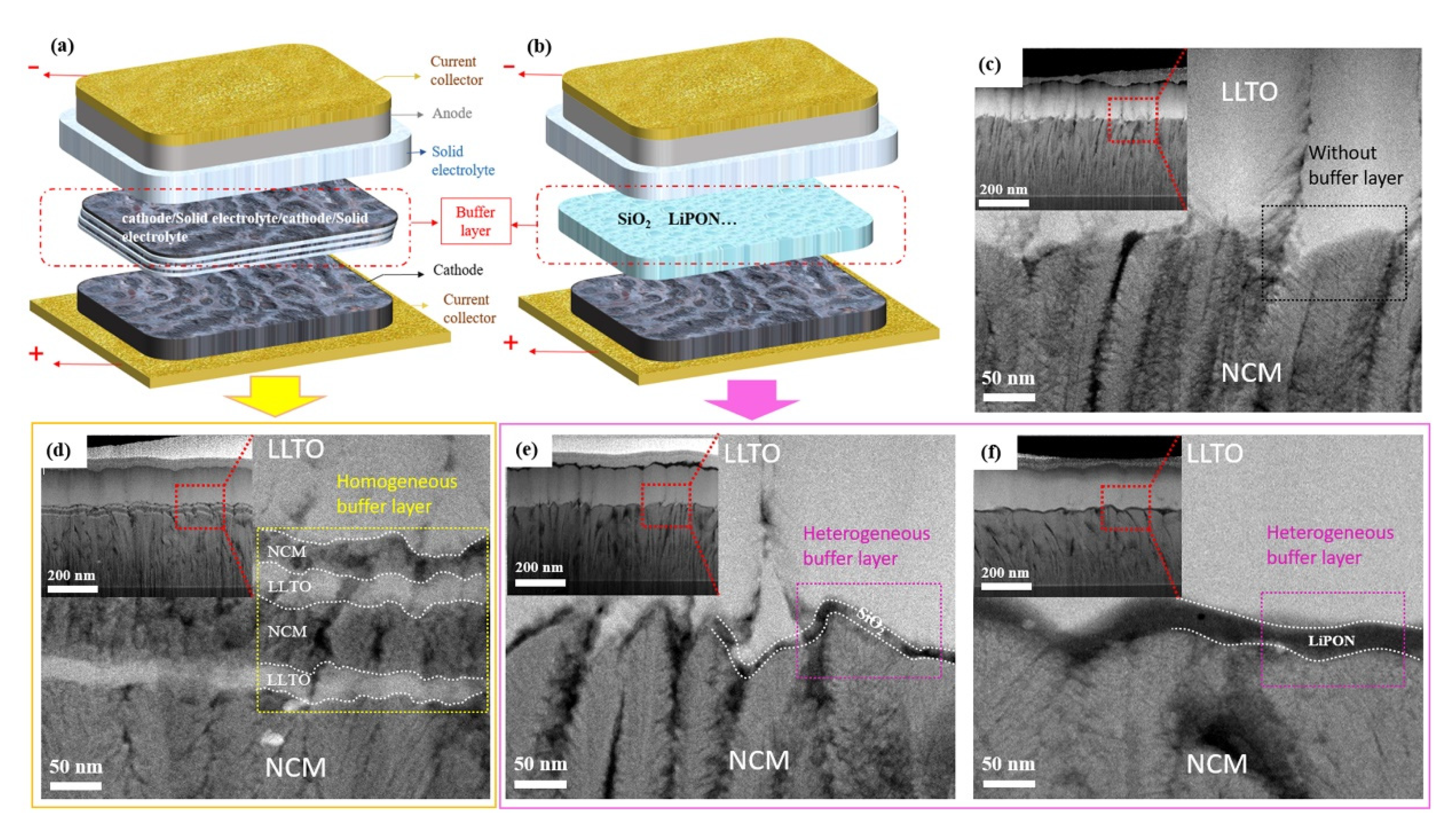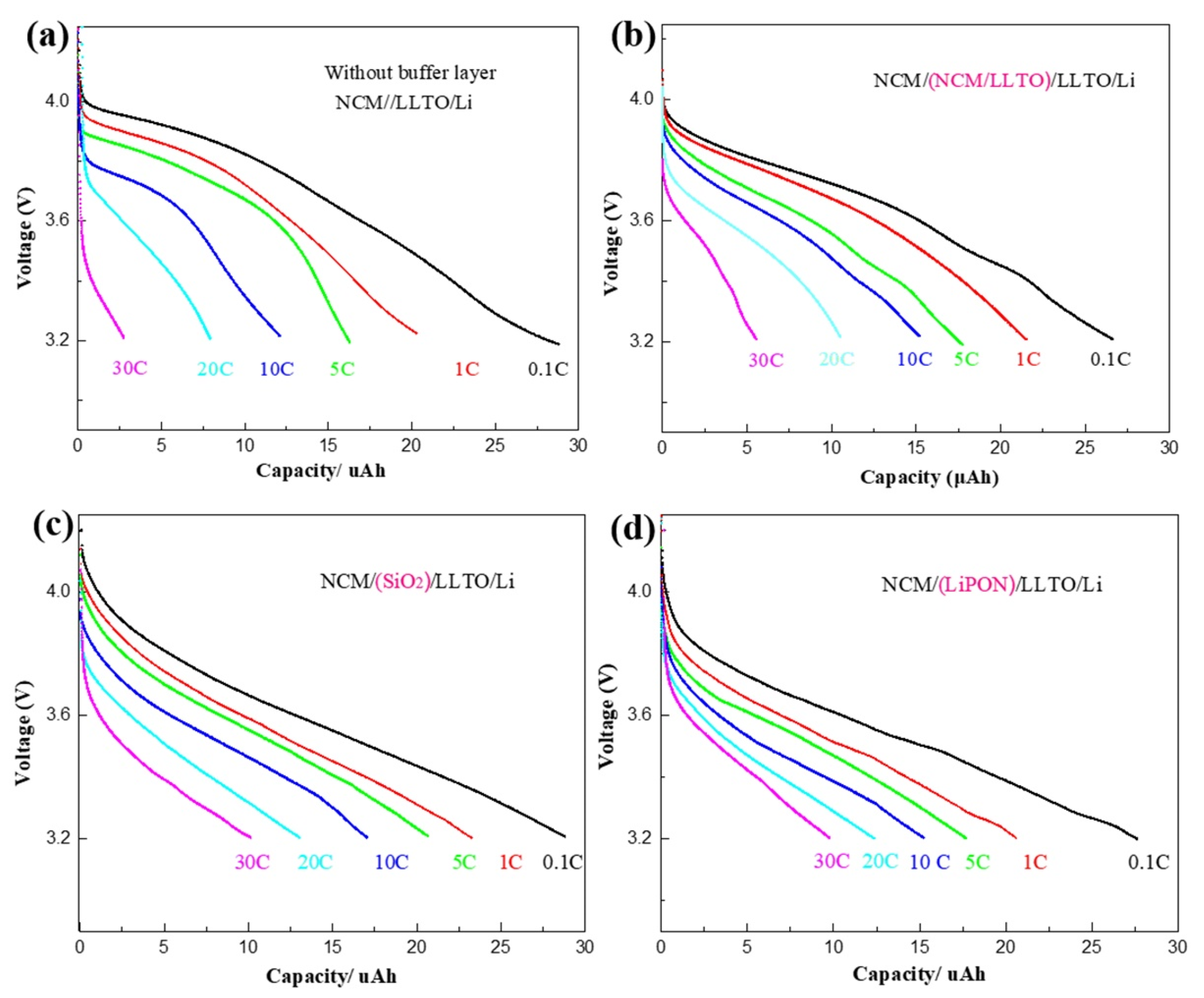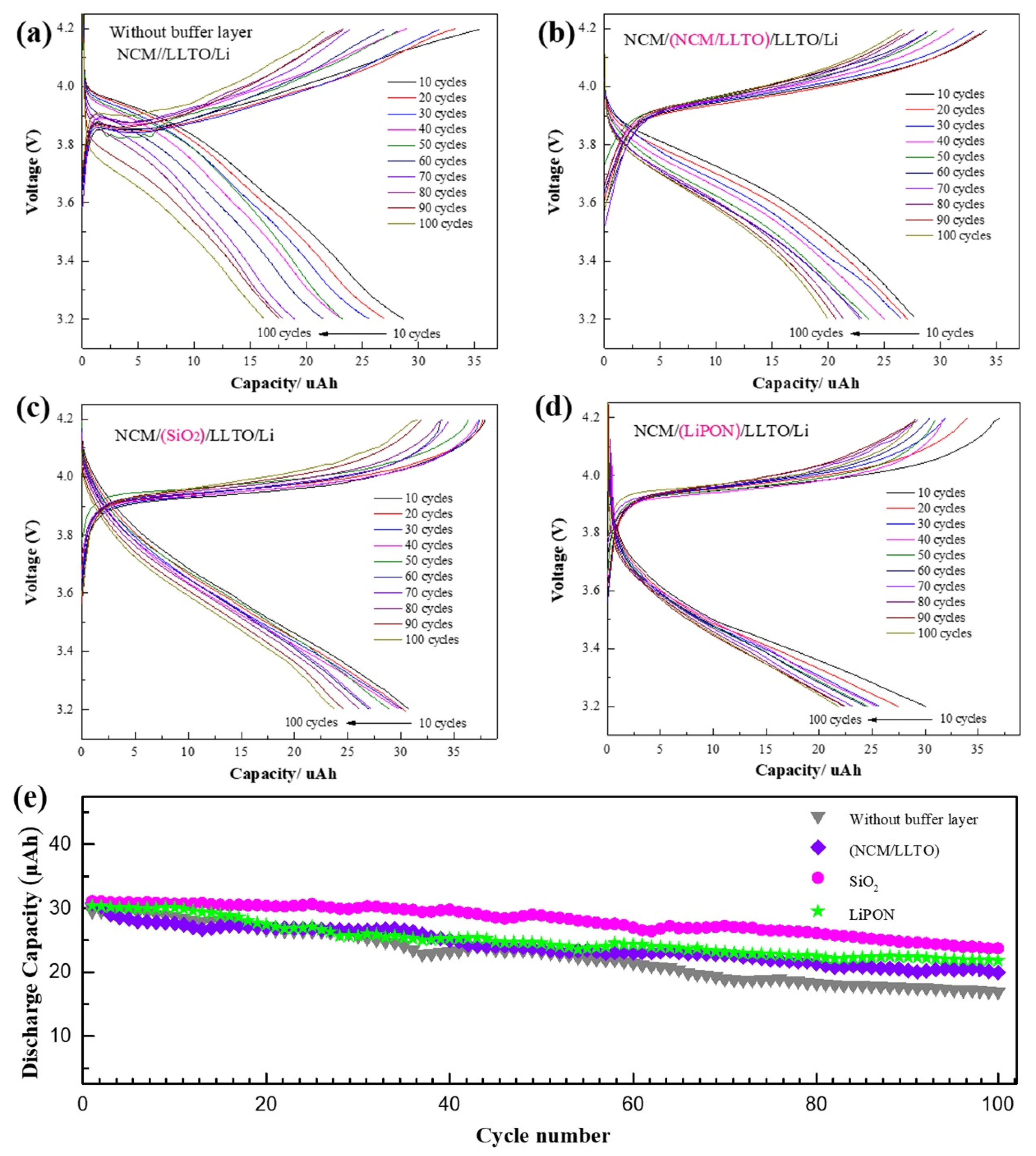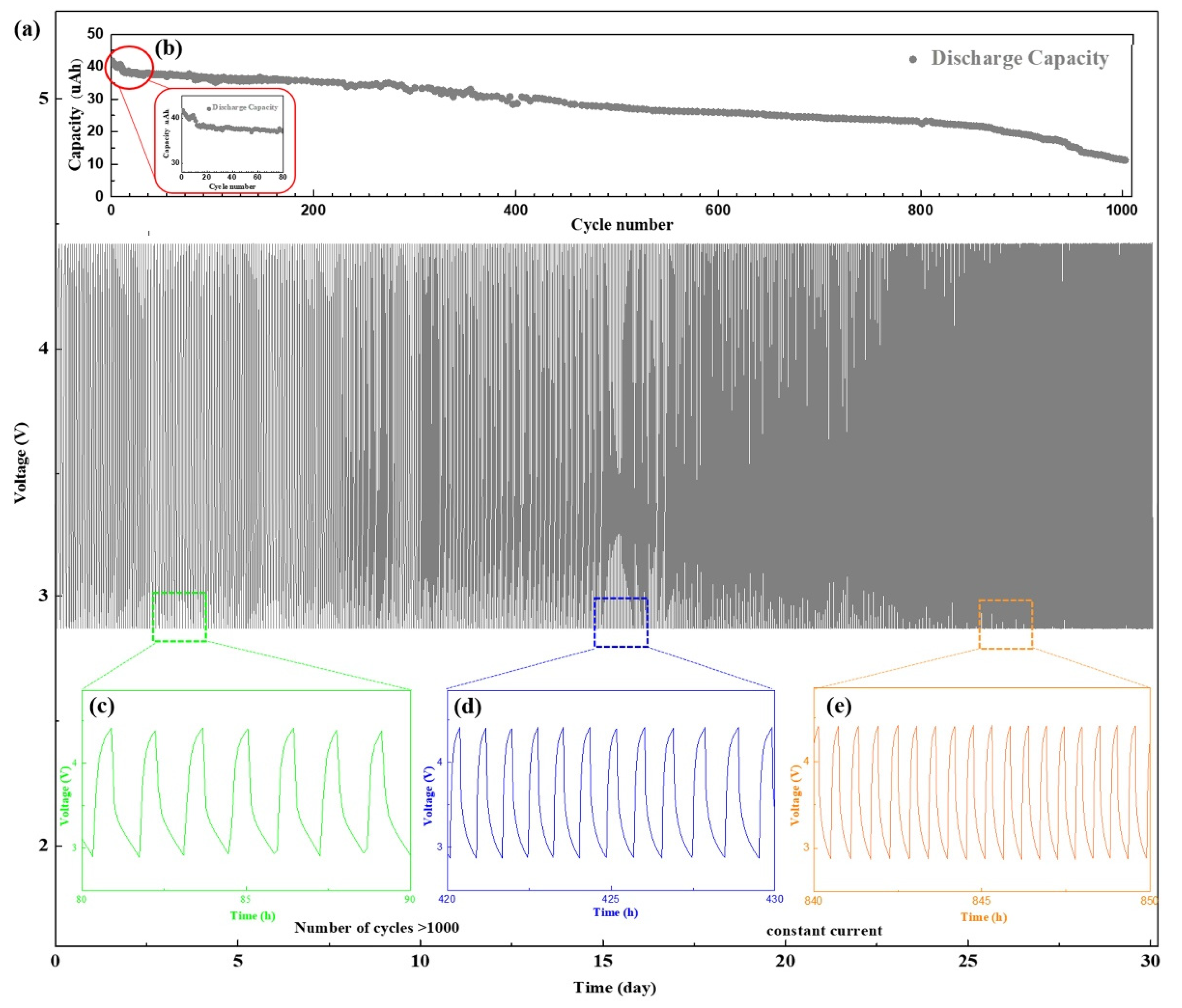Stabilization of Li0.33La0.55TiO3 Solid Electrolyte Interphase Layer and Enhancement of Cycling Performance of LiNi0.5Co0.3Mn0.2O2 Battery Cathode with Buffer Layer
Abstract
:1. Introduction
2. Materials and Methods
3. Results
3.1. LixLayTiO3 (LLTO) Solid Electrolyte
3.2. Microstructures of the Samples with Different Buffer Layers
3.3. Performance of the Batteries with Different Buffer Layer
3.3.1. Rate Characteristics
3.3.2. Cycle Performance
3.3.3. Cycle Performance of Battery with SiO2 Buffer Layer
4. Conclusions
Author Contributions
Funding
Data Availability Statement
Conflicts of Interest
References
- Mo, R.; Li, F.; Tan, X.; Xu, P.; Tao, R.; Shen, G. High-quality mesoporous graphene particles as high-energy and fast-charging anodes for lithium-ion batteries. Nat. Commun. 2019, 10, 1–10. [Google Scholar] [CrossRef] [PubMed] [Green Version]
- Yang, X.; Ma, H.; Zhang, G. Silica/carbon composites with controllable nanostructure from a facile one-step method for lithium-ion batteries application. Adv. Mater. Interfaces 2019, 6, 1801809. [Google Scholar] [CrossRef]
- Yang, H.; Liu, B.; Bright, J.; Kasani, S.; Wu, N. A single-ion conducting uio-66 metal-organic framework electrolyte for all-solid-state lithium battery. ACS Appl. Energ. Mater. 2020, 3, 4007–4013. [Google Scholar] [CrossRef]
- Gao, Z.; Sun, H.; Fu, L.; Ye, F.; Zhang, Y.; Luo, W. Promises, challenges, and recent progress of inorganic solid-state electrolytes for all-solid-state lithium batteries. Adv. Mater. 2018, 30, 1705702. [Google Scholar] [CrossRef] [PubMed]
- Kim, H.; Oh, Y.; Kang, K.; Kim, J.; Kim, J.; Yoon, C. Characterization of sputter-deposited licoo2 thin film grown on nasicon-type electrolyte for application in all-solid-state rechargeable lithium battery. ACS Appl. Mater. Interfaces 2017, 9, 16063–16070. [Google Scholar] [CrossRef]
- Rao, R.; Adams, S. Studies of lithium argyrodite solid electrolytes for all-solid-state batteries. Phys. Status Solidi-R 2011, 208, 1804–1807. [Google Scholar] [CrossRef]
- Ryoji, I.; Satoshi, Y.; Masaru, T.; Keiji, T.; Tomohiro, T.; Yoji, S. Development of lithium stuffed garnet-type oxide solid electrolytes with high ionic conductivity for application to all-solid-state batteries. Front. Energy Res. 2016, 4, 28. [Google Scholar]
- Zhang, L.; Yang, K.; Mi, J.; Lu, L.; Zeng, H. Solid electrolytes: Na3PSe4: A novel chalcogenide solid electrolyte with high ionic conductivity. Adv. Energy Mater. 2016, 5, 39–41. [Google Scholar]
- Jean-Christophe, D.; Alexandre, A.; Ashok, V.; Karim, Z. Solid-state nmr study of new copolymers as solid polymer electrolytes. Magn. Chem. 2018, 4, 13. [Google Scholar]
- Pal, P.; Ghosh, A. Investigation of ionic conductivity and relaxation in plasticized pmma-LiClO4 solid polymer electrolytes. Solid State Ion. 2018, 319, 117–124. [Google Scholar] [CrossRef]
- Rao, J.; Liu, N.; Zhang, Z.; Su, J.; Li, L.; Xiong, L.; Gao, Y. All-fiber-based quasi-solid-state lithium-ion battery towards wearable electronic devices with outstanding flexibility and self-healing ability. Nano Energy. 2018, 51, 425–433. [Google Scholar] [CrossRef]
- Yang, Z.; Luo, Y.; Gao, X.; Wang, R. High-Safety All-Solid-State Lithium-Ion Battery Working at Ambient Temperature with In Situ UV-Curing Polymer Electrolyte on the Electrode. ChemElectroChem 2020, 7, 2599–2607. [Google Scholar] [CrossRef]
- Lee, S. Scalable and safer printed Zn//MnO2 planar micro-batteries for smart electronics. Natl. Sci. Rev. 2020, 7, 5–6. [Google Scholar] [CrossRef]
- Suzuki, K.; Mashimo, N.; Ikeda, Y.; Yokoi, T.; Hirayama, M.; Kanno, R. High cycle capability of all-solid-state lithium–sulfur batteries using composite electrodes by liquid-phase and mechanical mixing. ACS Appl. Energy Mater. 2018, 1, 2373–2377. [Google Scholar] [CrossRef]
- Shin, R.; Son, S.; Lee, S.; Han, Y.; Kim, Y.; Ryu, S. Effect of li₃bo₃ additive on densification and ion conductivity of garnet-type Li7La₃Zr₂O12 solid electrolytes of all-solid-state lithium-ion batteries. J. Korean Ceram. Soc. 2016, 53, 712–718. [Google Scholar] [CrossRef]
- Noh, S.; Kim, J.; Eom, M.; Shin, D. Surface modification of LiCoO2 with li3xla2/3xtio3 for all-solid-state lithium ion batteries using Li2S–P2S5 glass-ceramic. Ceram. Int. 2013, 39, 8453–8458. [Google Scholar] [CrossRef]
- Paik, B.; Matsuo, M.; Sato, T.; Qu, L.; Wolczyk, A.; Orimo, S. Effect of the structural evolution on the ionic conductivity of Li-N-H system during the dehydrogenation. Appl. Phys. Lett. 2016, 108, 213903. [Google Scholar] [CrossRef]
- Prosini, P.; Mancini, R.; Petrucci, L.; Contini, V.; Villano, P. Li4Ti5O12 as anode in all-solid-state, plastic, lithium-ion batteries for low-power applications. Solid State Ion. 2001, 144, 185–192. [Google Scholar] [CrossRef]
- Li, B.; Su, Q.; Yu, L.; Wang, D.; Xu, B. Li0.35la0.55TiO3 nanofibers enhanced poly(vinylidene fluoride)-based composite polymer electrolytes for all-solid-state batteries. ACS Appl. Mater. Interfaces 2019, 11, 42206–42213. [Google Scholar] [CrossRef]
- Zhu, P.; Yan, C.; Dirican, M.; Zhu, J.; Zang, J.; Ramakrishnan, K. Li0.33La0.557TiO3 ceramic nanofiber-enhanced polyethylene oxide-based composite polymer electrolytes for all-solid-state lithium batteries. J. Mater. Chem. A 2018, 6, 4279–4285. [Google Scholar] [CrossRef]
- Zhang, Y.; Zheng, Z.; Liu, X.; Chi, M.; Wang, Y. Fundamental relationship of microstructure and ionic conductivity of amorphous LLTO as solid electrolyte material. J. Electrochem. Soc. 2019, 166, A515–A520. [Google Scholar] [CrossRef]
- Lee, S.; Bae, J.; Son, J. Structural and electrical effects of Y-doped Li0.33La0.56xYxTiO3 solid electrolytes on all-solid-state lithium ion batteries. J. Korean Phys. Soc. 2019, 74, 73–77. [Google Scholar] [CrossRef]
- Manthiram, A.; Yu, X.; Wang, S. Lithium battery chemistries enabled by solid-state electrolytes. Nat. Rev. Mater. 2017, 2, 1–16. [Google Scholar] [CrossRef]
- Erickson, E.; Li, W.; Dolocan, A.; Manthiram, A. Insights into the cathode-electrolyte interphases of high-energy-density cathodes in lithium-ion batteries. ACS Appl. Mater. Interfaces 2020, 12, 16451–16461. [Google Scholar] [CrossRef]
- Ohta, S.; Komagata, S.; Seki, J.; Saeki, T.; Morishita, S.; Asaoka, T. All-solid-state lithium ion battery using garnet-type oxide and Li3BO3 solid electrolytes fabricated by screen-printing. J. Power Sources 2013, 238, 53–56. [Google Scholar] [CrossRef]
- Zhang, W.; Richter, F.H.; Culver, S.P.; Leichtweiss, T.; Lozano, J.G.; Dietrich, C.; Bruce, P.G.; Zeier, W.G.; Janek, J. Degradation mechanisms at the Li10GeP2S12/LiCoO2 cathode interface in an all-solid-state lithium-ion battery. ACS Appl. Mater. Interfaces 2018, 10, 22226–22236. [Google Scholar] [CrossRef]
- Yu, C.; Ganapathy, S.; Van Eck, E.R.; Wang, H.; Basak, S.; Li, Z.; Wagemaker, M. Accessing the bottleneck in all-solid state batteries, lithium-ion transport over the solid-electrolyte-electrode interface. Nat. Commun. 2017, 8, 1–9. [Google Scholar] [CrossRef] [PubMed]
- Hou, M.; Liang, F.; Chen, K.; Dai, Y.; Xue, D. Challenges and perspectives of nasicon-type solid electrolytes for all-solid-state lithium batteries. Nanotechnology 2020, 31, 132003. [Google Scholar] [CrossRef]
- Wang, Z.; Wang, Z.; Yang, L.; Wang, H.; Song, Y.; Han, L. Boosting interfacial li+ transport with a mof-based ionic conductor for solid-state batteries. Nano Energy 2018, 49, 580–587. [Google Scholar] [CrossRef]
- Su, Y.; Cui, S.; Zhuo, Z.; Yang, W.; Wang, X.; Pan, F. Enhancing the high-voltage cycling performance of LiNi0.5Mn0.3Co0.2O2 by retarding its interfacial reaction with an electrolyte by atomic-layer-deposited Al2O3. ACS Appl. Mater. Interfaces 2015, 7, 25105–25112. [Google Scholar] [CrossRef]
- Yoshinari, T.; Koerver, R.; Hofmann, P.; Uchimoto, Y.; Zeier, W.G.; Janek, J. Interfacial stability of phosphate-NASICON solid electrolytes in Ni-rich NCM cathode-based solid-state batteries. ACS Appl. Mater. Interfaces 2019, 11, 23244–23253. [Google Scholar] [CrossRef] [PubMed]
- Graetz, J.; Meng, Y.; Mcgilvray, T.; Yang, M.; Zhu, Y. In situ analytical electron microscopy for probing nanoscale electrochemistry. Electrochem. Soc. Interface 2011, 20, 49. [Google Scholar]
- Santhanagopalan, D.; Qian, D.; Mcgilvray, T.; Wang, Z.; Wang, F.; Camino, F. Interface limited lithium transport in solid-state batteries. J. Phys. Chem. Lett. 2014, 5, 298–303. [Google Scholar] [CrossRef] [PubMed] [Green Version]
- Zhou, Y.; Yue, J.; Hu, E.; Gu, L.; Nam, K. High-rate charging induced intermediate phases and structural changes of layer-structured cathode for lithium-ion batteries. Adv. Energy Mater. 2016, 6, 1600597. [Google Scholar] [CrossRef]
- Matsuda, Y.; Kuwata, N.; Kawamura, J. Thin-film lithium batteries with 0.3–30 μm thick LiCoO2 films fabricated by high-rate pulsed laser deposition. Solid State Ion. 2018, 320, 38–44. [Google Scholar] [CrossRef]
- Yue, J.; Zhu, X.; Han, F.; Fan, X.; Wang, L.; Yang, J.; Wang, C. A long-cycle life all-solid-state sodium ion battery. ACS Appl. Mater. Interfaces 2018, 10, 39645–39650. [Google Scholar] [CrossRef]
- Grillon, N.; Bouyssou, E.; Jacques, S.; Gautier, G. Cycle life and statistical predictive reliability model for all-solid-state thin film microbatteries. Microelectron. Reliab. 2019, 93, 102–108. [Google Scholar] [CrossRef]
- Sluytman, J.; West, W.; Whitacre, J.; Alamgir, F.; Greenbaum, S. Cycling-induced degradation of LiCoO2 thin-film cathodes at elevated temperature. Electrochim. Acta. 2006, 51, 3001–3007. [Google Scholar] [CrossRef]
- Sakuda, A.; Kitaura, H.; Hayashi, A.; Tadanaga, K.; Tatsumisago, M. Improvement of high-rate performance of all-solid-state lithium secondary batteries using LiCoO2 coated with Li2O–SiO2 glasses. Electrochem. Solid ST 2007, 11, A1. [Google Scholar] [CrossRef]
- Hakari, T.; Hayashi, A.; Tatsumisago, M. Li2S-based solid solutions as positive electrodes with full utilization and superlong cycle life in all-solid-state Li/S batteries. Adv. Sustain. Syst. 2017, 1, 1700017. [Google Scholar] [CrossRef]
- Dudney, N.J. Evolution of the lithium morphology from cycling of thin film solid state batteries. J. Electroceram. 2017, 38, 222–229. [Google Scholar] [CrossRef]





| Sample | A | B | C | D |
|---|---|---|---|---|
| Type | Without Buffer Layer | Homogeneous Buffer Layer | Heterogeneous Buffer Layer | Heterogeneous Buffer Layer |
| Buffer layer | / | Li0.33La0.55TiO3/ LiNi0.5Co0.3Mn0.2O2 (LLTO/NCM) | SiO2 | LiPON |
| Battery structure | NCM/LLTO/Li | NCM/(LLTO/NCM)/LLTO/Li | NCM/SiO2/LLTO/Li | NCM/LiPON/LLTO/Li |
Publisher’s Note: MDPI stays neutral with regard to jurisdictional claims in published maps and institutional affiliations. |
© 2021 by the authors. Licensee MDPI, Basel, Switzerland. This article is an open access article distributed under the terms and conditions of the Creative Commons Attribution (CC BY) license (https://creativecommons.org/licenses/by/4.0/).
Share and Cite
Tan, F.; An, H.; Li, N.; Du, J.; Peng, Z. Stabilization of Li0.33La0.55TiO3 Solid Electrolyte Interphase Layer and Enhancement of Cycling Performance of LiNi0.5Co0.3Mn0.2O2 Battery Cathode with Buffer Layer. Nanomaterials 2021, 11, 989. https://doi.org/10.3390/nano11040989
Tan F, An H, Li N, Du J, Peng Z. Stabilization of Li0.33La0.55TiO3 Solid Electrolyte Interphase Layer and Enhancement of Cycling Performance of LiNi0.5Co0.3Mn0.2O2 Battery Cathode with Buffer Layer. Nanomaterials. 2021; 11(4):989. https://doi.org/10.3390/nano11040989
Chicago/Turabian StyleTan, Feihu, Hua An, Ning Li, Jun Du, and Zhengchun Peng. 2021. "Stabilization of Li0.33La0.55TiO3 Solid Electrolyte Interphase Layer and Enhancement of Cycling Performance of LiNi0.5Co0.3Mn0.2O2 Battery Cathode with Buffer Layer" Nanomaterials 11, no. 4: 989. https://doi.org/10.3390/nano11040989
APA StyleTan, F., An, H., Li, N., Du, J., & Peng, Z. (2021). Stabilization of Li0.33La0.55TiO3 Solid Electrolyte Interphase Layer and Enhancement of Cycling Performance of LiNi0.5Co0.3Mn0.2O2 Battery Cathode with Buffer Layer. Nanomaterials, 11(4), 989. https://doi.org/10.3390/nano11040989





